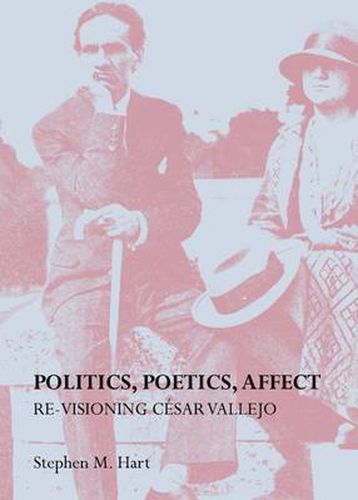Readings Newsletter
Become a Readings Member to make your shopping experience even easier.
Sign in or sign up for free!
You’re not far away from qualifying for FREE standard shipping within Australia
You’ve qualified for FREE standard shipping within Australia
The cart is loading…






This book seeks to re-vision the life and work of the Peruvian poet, Cesar Vallejo (1892-1938). It consists of ten essays grouped into three complementary sections on Politics, Poetics and Affect. In Part I, William Rowe draws out the latent layers of political meaning in Vallejo’s ‘pre-political’ work, Trilce; Adam Feinstein weighs the evidence for and against the case that there was a rift between the two most important Latin American poets of the twentieth century (Vallejo and Pablo Neruda); and David Bellis compares and contrasts Vallejo’s Spanish Civil War poetry with that composed by Neruda and the Cuban poet Nicolas Guillen. In Part II, Dominic Moran provides a line-by-line dissection of Vallejo’s favourite poem of his early period, ‘El palco estrecho’; Adam Sharman offers a close reading of Poem XXIII of Trilce; Paloma Yannakakis looks at the role played by the human body in Vallejo’s poetics; while Michelle Clayton reviews the ways in which animals are represented in Vallejo’s poetry. In Part III, Santi Zegarra discusses the influence that Vallejo’s poetry has had on his film-making; Eduardo Gonzalez Viana reveals how he re-created Vallejo’s experience of imprisonment in his novel Vallejo en los infiernos; while Stephen Hart compares and contrasts the two main muses of Vallejo’s early poetry, his niece (Otilia Vallejo Gamboa) and the woman he met in Lima (Otilia Villanueva Pajares).
$9.00 standard shipping within Australia
FREE standard shipping within Australia for orders over $100.00
Express & International shipping calculated at checkout
This book seeks to re-vision the life and work of the Peruvian poet, Cesar Vallejo (1892-1938). It consists of ten essays grouped into three complementary sections on Politics, Poetics and Affect. In Part I, William Rowe draws out the latent layers of political meaning in Vallejo’s ‘pre-political’ work, Trilce; Adam Feinstein weighs the evidence for and against the case that there was a rift between the two most important Latin American poets of the twentieth century (Vallejo and Pablo Neruda); and David Bellis compares and contrasts Vallejo’s Spanish Civil War poetry with that composed by Neruda and the Cuban poet Nicolas Guillen. In Part II, Dominic Moran provides a line-by-line dissection of Vallejo’s favourite poem of his early period, ‘El palco estrecho’; Adam Sharman offers a close reading of Poem XXIII of Trilce; Paloma Yannakakis looks at the role played by the human body in Vallejo’s poetics; while Michelle Clayton reviews the ways in which animals are represented in Vallejo’s poetry. In Part III, Santi Zegarra discusses the influence that Vallejo’s poetry has had on his film-making; Eduardo Gonzalez Viana reveals how he re-created Vallejo’s experience of imprisonment in his novel Vallejo en los infiernos; while Stephen Hart compares and contrasts the two main muses of Vallejo’s early poetry, his niece (Otilia Vallejo Gamboa) and the woman he met in Lima (Otilia Villanueva Pajares).